European Wines
A General Overview
Carpe diem. Vivere bene! Gratia Deo.
This is a brief overview of wines produced in Europe, an appendix to my book HOW TO EUROPE: The Complete Travelers Handbook. The entire book is published free on-line by the traveler, author, photographer, webmaster, and wine spitter — yours truly — with help from my daughter Stephanie and good friend Paula in Haarlem, The Netherlands. Patronage at euro-shoppe keeps this site on line. Questions, comments, contributions, and complaints are welcome. See NOTE TO READERS.
Since there are a guadzillion people writing about wine in the web universe you might be wondering "What does this Bermont guy know about wine?" I say, something like half a century and 15,000 bottles worth. Mon Dieu! See my wine qualifications below.
Updated .
Wine ott?
WHEN AND WHERE
Wine has been made for thousands of years. Records of wines and vineyards date from the earliest times of recorded history. After water and milk, wine is the oldest beverage known to man, and the best of the three.
The wine producing areas of the world generally lie between latitudes 30N and 52N and between 30S and 40S. This includes most of southern and central Europe, and many other areas around the word. We'll focus here on Europe since Europe is what this web site is all about.
France
Think France and you automatically think wine. France has 12 major wine producing areas. The most familiar are Bordeaux and Burgundy, but there is also Rhône, Alsace, Languedoc-Roussillon, and others. Best known red wine grapes are Merlot, Cabernet Sauvignon, Gamay, and Pinot Noir. The whites include Chardonnay, Sauvignon Blanc, and Chablis.
Germany
Germany has 13 distinct wine producing regions. Some of the areas are Mosel-Saar-Ruwer, Rheinhessen, Pfalz, and Nahe. The major grapes used in German white wine production are the Riesling, Kerner, and Silvaner. Blauer Spätburgunder, the German name for Pinot Noir, is the grape of some red wines.
Italy
Italy produces more wine than any other country, and has an almost endless number of wine regions. Well known wine producing areas include Piedmont, Lombardy, and Tuscany. Red and white wines are produced from a large number of grapes, perhaps 1,000 varieties. Red wines include Barbera, Montepulciano, Nebbiolo, and Sangiovese. The Trebbiano grape is the source of much of Italy's white wine. Another red, Primitivo, is very similar to California's Zinfandel, and some say that it is the same grape which was brought to California in the mid-1800s.
Spain
There are about 40 wine regions scattered throughout Spain. The best known include Rioja, Navarra, and Aragón. Major red wine grapes include Tempranillo, Grenacha Tinta, and Graciano. Viura is a major white wine variety.
Portugal
Vineyards are located throughout Portugal. There are three levels of appellation with approximately 45 regions. Major regions include Vinho Verde, Dao, Bairrada, Setubal Peninsula, and Alentejo. Popular white grapes are Alvarinho and Loueiro. Red wine grapes are Baga and Tinta Roriz. Portugal is also known for its fortified wines, namely Sherry, Port, and Madiera.
Austria
Austria is a significant wine producing nation even though it is not known as such because very little of its wine is exported. There are 4 major wine areas in Austria - Niederosterrich, Burgenland, Steiermark (Styria), and Wien (Vienna). These areas include 15 named wine regions. White grapes are Grüner Veltliner, Riesling, Müller-Thurgau, Weissburgunder (Pinot Blanc), and Rülander. Major red wine grapes include Zweigelt, Blauer Portugieser, and Blaufränkish.
Greece
I do not know much about Greek wine, except Retsina. I love it. Most people spit. Retsina is really great when having moussaka for dinner.
PROPER CARE OF WINES
You wouldn't store your milk on the kitchen counter or your bananas next to the fireplace. The same goes for wine.
Storage
Wines keep
very well and improve over the years when properly cared for.
- It is important to lay wine
on its side for long term storage. This keeps the cork from drying out.
If the cork should dry out, air can enter the bottle and help turn
your beautiful wine to bitter vinegar.
- Keep wine at a constant temperature in a cool dark place.
If you don't have a basement in which to
house your wine cellar, leave it in its box on its side and put the wine on the floor of
a closet or under the sink.
- Do not disturb your wine or "check it out" until you are ready to drink it.
Wines mature in the bottle and some throw a sediment of acidic crystals.
You definitely do not want this stuff in your glass.
Displaying Your Wines
If you wish to display your wines in a designer rack in a warm well-lighted place - kitchen or living room - display the bottles you have already enjoyed. Fill the empties with clear or colored water and recork them. Nobody will notice, or care, unless it's a burglar who broke in to steal your precious wines.
Á votre santé.
MY WINE QUALIFICATIONS
So how do you know that I know what I'm talking about when it comes to wine. My travel qualifications are written out at Meet The Author. There is nothing in that blurb about wine, eh?
Beginnings
Well, as a matter of fact I've been drinking the rouge for about half a century. I started out, probably like most kids, drinking Italian Lambrusco with pizza. Mateus from Portugal was another of my early favorites. When you are in college you drink what you can afford.
About 10 years into my career, in my early 30's, I moved to Southern California, Newport Beach to be specific. I was single and making good money as a chemical engineer. I wined and dined the girls a couple times a week. I started developing my taste buds and favorited a few wines. The most popular red wine at that time was cabernet sauvignon. Most people couldn't pronounce those big French words so they just ordered "cab." Another full bodied dry red wine, merlot, has also been a long time favorite in Southern California. Both of these grapes are the primary grapes in wines from the Bordeaux Appelation of France. They are also the mainstay of California red wines, and many wines from Australia, South Africa, Chile, and Argentina.
These Bordeaux grapes are OK but my taste buds kept probing around and found a better grape, pinot noir. As mentioned above, the pinot noir grape is the foundation of red wines from Borgougne. We know Borgougne as the Burgundy region of eastern France, centered on Dijon and Beaune. Pinot noir is also grown around the world. Pinot noir is generally less expensive than cabernet sauvignon or merlot, but I would pay more for it. I hear that there was a movie about pinot noir. Being as it came from Hollywood I assumed that it was blasphemous or stupid or both so I didn't see it.
Home Wine Tastings
My adopted home town, Newport Beach is blessed with many of the better things in life — sea, sail boats, sand, surf, sun, sunsets, etc., etc.. One of the man made blessings is a great wine store near 17th Street, not to mention nice selections of ruby liquids in most of the grocery stores in town. There is also one of those huge box warehouse stores nearby and a famous food import store in town, both of which have a good selection of good wine at good prices. You can buy almost anything with a cork in it. But even better than Newport Beach is Long Beach. I worked there for a few years and found a large wine shop near my office. This had the greatest selection of wines I had ever seen. I developed a wine shopping routine for Friday after work. Before getting on Pacific Coast Highway for my commute home I would drive to the wine store and buy a half case of various pinot noir wines from different wineries from all over the world. During the week I would conduct my own nightly wine tastings. In a few months I had tried everything in my mid range price level and selected one brand as my standard home wine. Thereafter I would buy it by the case and replenish the supply as I ran out. I didn't keep a "wine cellar" as such because I was living in apartments and had no room for that. Also, my favorite was a California brand, B.V., and was available everywhere. When I found it on sale I would clean the shelf. Let's hear it for free market wine prices!
Going International, Holland, France
My next move was to the Netherlands. To avoid too much redundancy take a look at my aforementioned Meet The Author travel bio. I lucked out with a company transfer to Haarlem, a beautiful city neaar Amsterdam. The Dutch don't make wine but plenty of the beverage and its cousins are available. I tasted just about everything in Holland and wherever I went on road trips around Europe. The American market is rather narrow and products available are limited, even in the well-endowed area where I lived. Europe has fine liquids that are unknown in the USA. After two years in Holland I came back to California and worked my way out of my job. So I went back to Europe to write my book, etc., etc. After getting the book published, a DIY job, and selling out several printings I went back to Europe. It was France this time on my own. I did my Paris life on the Left Bank and ended up with a wife.
Going International, Germany, France
After the baby we lucked out again with a company transfer to work in a Dorf near Frankfurt a/M for a couple of years. We lived in a big house on a cliff overlooking the Main River with a glimpse of the Schloss in Aschaffenburg. This is in a little finger of Bavaria, an area known as Franconia and/or Franken. Vineyards covered the hills just north of the city. Frankly, no pun intended, we were not impressed by the German wines. That area produces Silvaner grape white wines and there are no bargains. Elizabeth and I preferred red Burgundies. As for German red wines we learned fast that we didn't want to get close enough to even spit.
We rose to meet this challenge. Sinple, just drive over to Burgundy and get the real thing. So we loaded up the car with the million things that then two year old Stephanie needed and drove over to Dijon on Fridays for a weekend sortie. On Saturdays we drove around Beaune and Nuits-St-Georges looking for wine merchants with signs announcing degustation. Now that might sound like the wrong place to be, but it means "tasting." With the barrels and paintings of grape clusters all over the place we knew this is where we wanted to be. We also drove up into the hills and found some wineries welcoming us with their degustation signs. This was the Mother Lode.
We would walk in and try to find the proprietor. Here we are walking around all these tanks, barrels, and bottles full of vin de Bourgougne and there is nobody to be found! Finally we would find Authority and proceed to taste. We bought the wine en vrac, meaning "in bulk" rather than ready bottled. Polyproplyene containers of 10, 20, and 30 liter capacity could be purchased from the vintner. We accumulated a supply of these and had well over a 100 liter capacity for the wine expeditions, which we did two or three times a year. You do the math. We had wine every night.
Corker-in-Charge
I bought a supply of bottles, corks, and a corking tool. The vintner gave us the labels and we bought pine wood wine racks at Ikea. The week after the Burgundy trip I would cork our booty. There were 150 bottles. Mon Dieu! This is a lot of work, especially for a desk jockey, but it saved plenty of money compared to buying bottled wine. Here is a picture, wine purchase, a few years later as I bought more wine on a road trip from Milano to Amsterdam. Good habits are hard to break.
The Lost Wine
As I said in the caption to the intro photo above "I have no wine recommendations." But I would be remiss if I did not mention a couple of wines we "discovered" on these Burgundy sorties.
There is a Burgundy wine called passetoutgrains. This is a blend of wines produced from the pinot noir grape and the gamay grape. It can contain between ⅓ and ⅔ of each. The more pinot noir the better. Passetoutgrains is my favorite wine. I once tried to find it in California and after many phone calls I finally did. But it was not worth the effort. When you are in Burgundy you will find it easily.
The other "discovery" is a white wine. As you know chardonnay is the best known white wine of Burgundy. I used to smell it on the breath of my secretary in California. It is nauseating, especially the oak aged variety. There is another white grape in Burgundy, aligoté. I found this at a small winery somewhere in the hills around Beaune. I bought a ten liter carboy. Unfortunately, this is the lost wine. I could never find that winery again, and nobody in the USA has ever heard of this wine. There is an old saying that "export quality" is the stuff that the locals won't drink. If the locals won't export it what do you think?
Wine Consultant
In the late 90's I took a course and obtained a certificate as a bar tender. That certificate helped land a single one-night job as a bar man for a millenium charity celebration in Los Angeles. The one-off job nearly paid for the cost of the lessons.
A few years later the certificate helped me pull in a part-time job as a wine consultant for a wine importer. For several years I was part of teams conducting wine tastings at consumer trade shows nationwide — Los Angeles, St. Louis, Chicago, Detroit, Boston, etc. The objective was to sell wines. We were "consultants" in name only, more or less. I am barely a mediocre salesman but I had fun and met a lot of fellow wine drinkers along the way. We are the best people, you know.
Fini
I continue to make my own wine. That is an easy and safe thing to do. I learned how to do it out of necessity when I lived in Saudi Arabia for a year. Not only is the desert sand as dry as a bone but no alcohol is permitted in "The Kingdom," as they call it over there. It can be serious slammer time if you are caught. Those jails are straight out of the 15th century. I saw one in person, fortunately from the no-so-bad side of the bars.
My Dad would always say "Rules are made to be broken." I don't think he ever broke any laws but he liked to say that about the petty stuff. So I had a dozen bottles constantly under fermentation in my locked closet in Al-Khobar. If it wasn't locked up the apartment cleaning crew would take their share when I wasn't around. Anything with alcohol content is known as sidiki, "my friend," in The Kingdom.
To get the hard stuff we bought home booze from an established ex-pat guy. He delivered direct from the trunk of his car at a pre-arranged spot out in the desert. A buddy and I turned over a Bennie ($100 bill) and received a gallon jug of 190 proof uncut distilled alcohol. I am not making this stuff up. Do-it-yourself moonshine in The Kingdom is a threat to your life, liberty, and bank account. It is dangerous to make and some guys blew up their houses in the process. They would be immediately arrested and held for a year or so. Tales of The Kingdom could fill another chapter, maybe a book.
That's my wine story, up to now.
Here's mud in your eye. I learned that from my Dad also.
To like and like not:


Adverts
To support this site:
Please buy your goods at:Amazon.com
Shop in your shorts!
Please clean out your cookie jar before clicking.
Use a professional quality corkscrew for easy opening, and to keep the cork from falling ino the bottle.
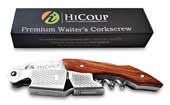 Waiters Corkscrew by HiCoup
Waiters Corkscrew by HiCoupPremium Rosewood All-in-one
Corkscrew, Bottle Opener, and Foil Cutter
For much more information consult these authoritative books.
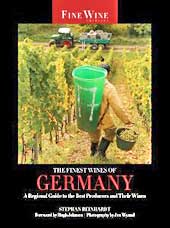 The Finest Wines of Germany:
The Finest Wines of Germany:
A Regional Guide to the Best Producers and Their Wines
by Stephan Reinhardt and Hugh Johnson
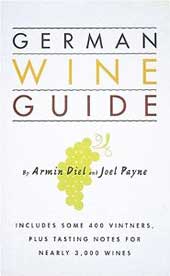 German Wine Guide
German Wine Guide
by Armin Diel and Joel Payne
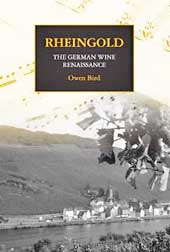 Rheingold - The German Wine Renaissance
Rheingold - The German Wine Renaissance
by Owen Bird
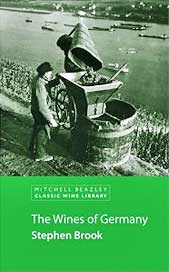 The Wines of Germany (Classic Wine Library)
The Wines of Germany (Classic Wine Library)
by Stephen Brook
Here is probably more than you'll ever need to know about wine.
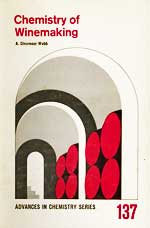 Chemistry of Winemaking
Chemistry of Winemaking
by A. Dinsmoor Webb
Published by the American Chemical Society
The Marling Menu Master series is the best for interpreting restaurant offerings in Germany.
 Marling Menu Master
Marling Menu MasterGermany
 The Wine Roads of Europe
The Wine Roads of Europe
by Marc and Kim Million
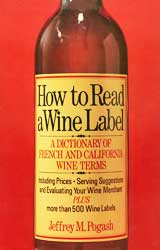 How To Read a Wine Label
by Jeffrey M. Pogash
How To Read a Wine Label
by Jeffrey M. Pogash
Another choice for a German menu reader is Langenscheidt's.
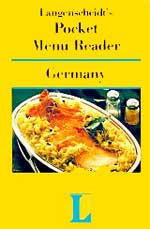 Langenscheidt's Pocket Menu Reader Germany
Langenscheidt's Pocket Menu Reader Germany
Another choice for a menu reader is Berlitz.
 Berlitz European Menu Reader: For Eating Out in over 25 Countries
Berlitz European Menu Reader: For Eating Out in over 25 Countries
The Berlitz pocket dictionary should cover you in most situations.
 German Pocket Dictionary Berlitz
German Pocket Dictionary Berlitz
Free to use but not to abuse.
Copyright:
Internet edition
© 2001-2016 James J. Broad
All rights reserved. Tous droits réservés.
This is copyrighted material. Do not reproduce, copy, plagiarize, re-craft,
store, modify, extract, transmit, or purloin any part of this
publication in any nation in any form or by any means or for any purpose whatsoever without permission
in writing.
Copying:
You may print one paper copy of this web page for your personal use.
Permissions:
If you want to adapt any part of this material to use in your blog, forum, web site, book, article,
speech, term paper, movie, video, or any other media please write to me and get
permission before you do so. Otherwise it is a copyright violation or plagiarism.
Plagiarism includes paraphrasing text and copying ideas. Imitation,
the old saying goes, may be the highest form of flattery. However, plagiarism is outright theft and is usually
compounded by the lies of the perpetrator.
Everything on my web site is original, created at great personal expense
in time and cash in the course of my extensive travels throughout Europe. Please respect my property.
For detailed descriptions of the many forms of plagiarism see
Plagiarism.org and
A Plagiarism Guide for Students.
For permission to use material from this web site contact:
johnbermont@enjoy-europe.com.
Webmasters:
You may link the URL http://www.enjoy-europe.com/wine.htm freely. Please do. When you link please send the URL for your linking page and a crosslink will be installed in one of the categories of the TRAVELERS YELLOW PAGES to your site if it has significant content for travelers in Europe.
Free, free, and free
This web site is totally free for everyone, and a labor of love for me.
Support
To keep enjoy-europe.com afloat I advertise scores of travel related books and products. My site receives
a commission from Amazon.com for all goods purchased through the advert links. These advert links are
displayed on individual pages and on my on-line store at
 . Your support is most gratefully appreciated. TIA.
. Your support is most gratefully appreciated. TIA.
Your Blow Back
I welcome questions, comments, and complaints. If you have any concerns about your trip to Europe that have not been covered well enough on my web site please do not hesitate to write. Ask, cuss, discuss, or whatever. I read every email and update my pages when I see a question repeating,
Utilities:
- How To Europe: The Complete Travelers Handbook.
- Home.
- To the top of this page
- E-Mail to John Bermont
- Meet the Author
- Privacy Policy
- Site Map
- Advertising Policy

